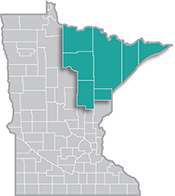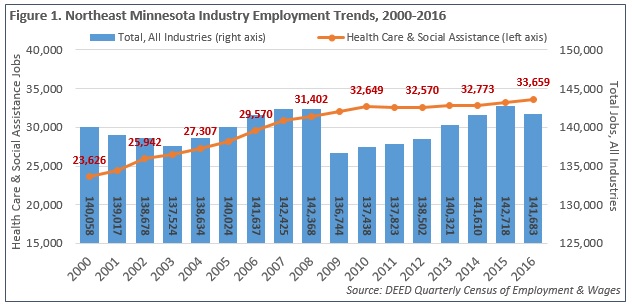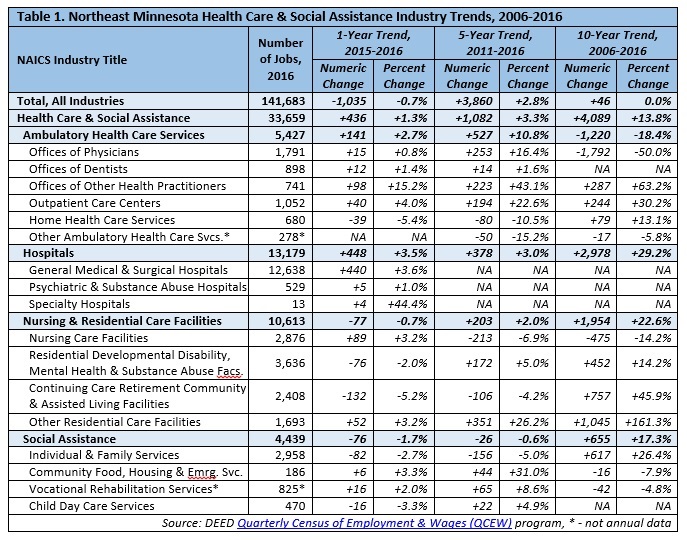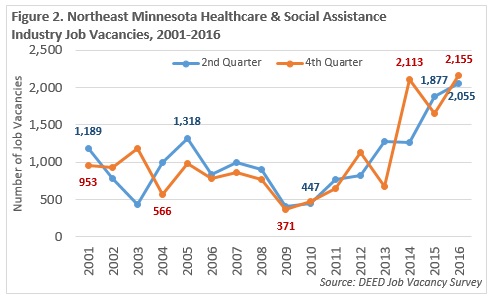 Home to the state's second-largest metro, the Northeast Region has a strong industrial sector, tied largely to the area's abundant natural resources.
Home to the state's second-largest metro, the Northeast Region has a strong industrial sector, tied largely to the area's abundant natural resources.
Most of the manufacturing base centers on mining and forest products industries. More than half of the sector's employment is in paper and machinery manufacturing.
Want the freshest data delivered by email? Subscribe to our regional newsletters.
6/22/2017 12:04:56 PM
Erik White
Despite economic fluctuations in the region across other industries, health care and social assistance providers in Northeast Minnesota continually added jobs over the past 16 years. Health care and social assistance accounted for 16.9 percent of total jobs in 2000, but after gaining just over 10,000 jobs from 2000 to 2016, the industry now comprises 23.8 percent of total employment, the highest share it has ever provided. While the number of jobs across the total of all industries has expanded 1.2 percent from 2000 to 2016, the health care and social assistance industry has jumped 42.5 percent (Figure 1).

Health care and social assistance has become an increasingly important part of Northeast Minnesota’s economy over the past decade, adding just over 4,000 jobs from 2006 to 2016, a 13.8 percent rise. That was enough to compensate for losses across all other industries, which saw a decline in the past 10 years. And although the region saw a decline of 1,035 jobs in the past year, health care continued expanding and added 436 net new jobs, a 1.3 percent increase.
Already the largest employing sector, hospitals also saw the largest and fastest increase in jobs over the past decade, though some of that was due to acquisitions, where hospitals took over offices of physicians, which appeared to lose jobs from 2006 to 2016. The region also saw significant job growth in nursing and residential care facilities, especially at other residential care facilities, which nearly tripled in size, and community care and assisted living facilities for the elderly, which jumped over 45 percent. Individual and family services gained over 600 net new jobs from 2006 to 2016, and residential developmental disability, mental health, and substance abuse facilities added over 450 jobs.
The biggest job gain in the past year occurred at general medical and surgical hospitals, which expanded by 440 jobs since 2015, followed by strong gains in offices of other health practitioners, nursing care facilities, other residential care facilities, and outpatient care centers (Table 1).

The steady increase in health care and social assistance employment since 2000 has led to a growing number of job vacancies across Northeast Minnesota as well, with the exception of a brief decline in hiring activity during the Great Recession from 2008 to 2010. In fact, the 2,155 job vacancies reported by health care and social assistance employers in the fourth quarter of 2016 was the highest number ever posted, besting the record set in 2014. It was also nearly a 500 percent increase in job postings compared to the low point set in 2009 (Figure 2).

Contact Erik White at erik.white@state.mn.us or 218-302-8413.